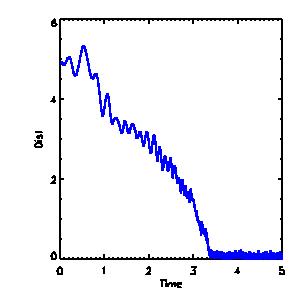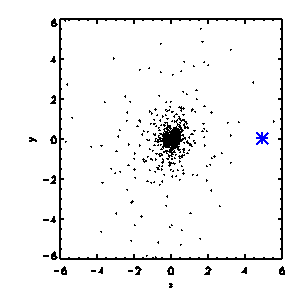T10: Dynamical Friction
We are now going to use a live plummer sphere and inject a heavy particle on
a circular orbit to see it sinking down to the minimum potential due to dynamical friction.
Before the tutorials:
Do, think about, and research the following:
- Bring your own program to the level of the example given for the last tutorial,
so that you can start from a clean and working version.
- What is dynamical friction ?
- What is the approximate timescale of the process ?
Hint: For a short introduction to the subject, see chapter 4.5 of the PhD thesis of
Francesca Iannuzzi.
During the tutorials:
Program it!
- load the particles from the file
plummer_1000.ascii or plummer_10000.ascii.gz or plummer_100000.ascii.gz
Hint: Switch the internal units to
m_unit = 1.989e43; // 1e10 Msol
l_unit = 3.085678e21; // kpc
v_unit = 1e5; // km/s
t_unit = l_unit / v_unit;
- Add a particle with a twenty time larger mass on a circular
orbit at a distance of five length units. Recall how to calculate
the circular velocity of such particle.
- Try to plot the orbit of the test particle with time and compare
to the expectation.
Example programs:
These are just examples.
- C/C++:
- F90:
- Simple version (this is sufficient for the moment, but it doesn’t hurt you to start improving it as suggested above):
T10.f90
(colorized),
Makefile
(colorized) (rename to “Makefile” or use with “make -f Makefile_gfortran”)
- More complex version:
(To be added later. We will reorganize the program structure when we get to multiple particles; think about how you would do this on your own.)
Discussion of the results:
Plot your results with gnuplot and plot the behaviour of the systems.
Can you explain what you see ?
Example plots:
Programming goals for T10:
Having many particles in our system and getting the program slow, we might think on a trivial
parallelization. If you havn't done last time (T9), then think about:
- What independent within a independent loop ?
- What is the most time consuming loop where you should do something ?
- Which loop is difficult to be paralleled and why ?
If your computer has multiple cores, you can parallelize independent loops by adding
#pragma omp parallel for
in front of it. To tell the compiler to compile with OpenMP, you have to add
-openmp
to the options in the Makefile. You can control how may cores should be
used by the program by the setting the environment variable
export OMP_NUM_THREADS=4

